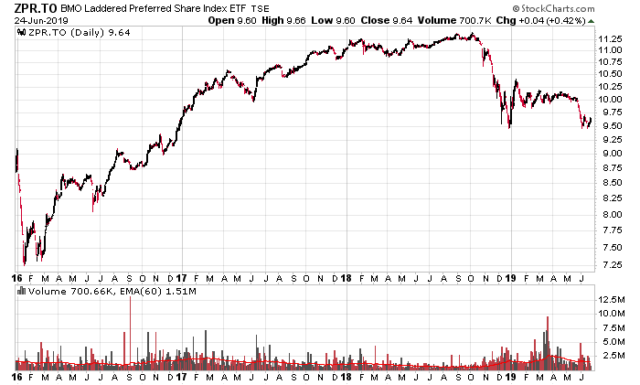Early 2016 was a good time to invest in Canadian preferred shares, and there was also a lot of carnage in the equity market at the time. Five-year government bond yields bottomed at 0.48% in February 2016, and you can see the damage it did to the preferred share market – ZPR is an ETF that tracks 5-year rate resets:
What is interesting is a well-timed entry on the bottom (not completely clairvoyant, but say $7.50/unit) and an exit anytime between October 2017 to 2018 would have netted a total return that exceeded the TSX with less risk. Of course, you can’t determine those preferred shares will do better than the TSX when you’re sitting at your computer console in February 2016!
Today’s investing environment has plenty of parallels – the 5-year interest rate has dropped to 135bps from 240bps back in October. If 5-year yields continue to drop further, there is a high degree of likelihood that preferred shares will also be sold down to levels seen in 2016.
The question is getting the timing correct.
A lot of retail investors get burnt by buying into a relatively high yield product thinking it is safe. While the yield itself may be safe (it has been awhile since I can recall a dividend suspension in the Canadian preferred share marketplace beyond Aimia and some really garbage split-share corps), the capital is most certainly at risk. It looks like a very easy leveraged trade on paper when margin rates are 2.5% and you see a financial instrument at 5%, but how much pain can you take when the yield goes to 6%? 7%? You’ve just lost nearly 17% and 29% of your capital, respectively.
Using a real example, investors in Brookfield Preferred Shares series 30 (TSX: BAM.PR.Z) back in September was trading at par, had a near-guarantee 4.7% yield, and a rate reset of 2.96% over the 5-year government bond rate. Some enterprising chap sees margin rates at 2.5% and decides to invest $50,000 cash to buy $100,000 of BAM.PR.Z. Now they’re sitting on $23,000 in equity plus $3,500 in accumulated dividends and they would have surely received a margin call (or would be very close to one). How much of the population out there is leveraged to preferred shares in this manner and are feeling nervous? How many will hit the sell button to take the tax hit and move away from this “guaranteed leveraged return”?
Ideally when they all want to cash out, that’s the time to get in. Doesn’t quite feel time yet.

“You’ve just lost nearly 17% and 29% of your capital, respectively.”
Yes and no. Obviously, this is correct if we consider unrealized losses on a mark to market basis. However, a large cohort of market actors in the preferred space easily pass the IFRS test of “willingness and ability to hold” for the long term. In such cases, valuations of preferreds in portfolios can very plausibly be on marked to model basis and thus be indifferent to temporary (at a large family office scale of operations temporary can be measured in years) market price fluctuations. These actors can be more than happy to purchase the yield with little concern for downside (especially with resets), especially since active trading among series of a single issuer can provide additional income.
“How much of the population out there is leveraged to preferred shares in this manner and are feeling nervous?”
This is an excellent question. With some of the knock-out yields available on low credit quality issuers such as Dundee Corporation, there are certainly some. I’d love to know the answer to this!
Good article. I profited from the 2016-18 run-up (not as much as I’d like.. hindsight bias I guess) and also feel that it’s not quite time yet. The prices may fall below the 2016 lows because the whole world is going to ZIRP again. Meanwhile, I am doing the background research on these rate-reset securities now and try to identify the best prospects.
One note on ZPR… I look at the price charts at several websites (TMX money, BMO, and Yahoo!) and don’t see the $7.50 low… the low was more like $8.6. Don’t think it’s important though as you probably would buy the individual stocks instead of the ETF anyways.
Where do you see margin rate of 2.5%? IB?
@EL: Stockcharts conveniently adjusts for dividends so it is a total return chart.
Margin: https://www.interactivebrokers.com/en/index.php?f=1595 – I just arbitrarily picked the $140k-$1.4M bracket for CAD but I’m sure creative traders out there can short 5-year German Bunds and get paid 66 basis points for it! (https://www.bloomberg.com/markets/rates-bonds/government-bonds/germany)
[…] on June 24, 2019 I put a notification out that Canadian preferred shares were looking interesting, but really […]